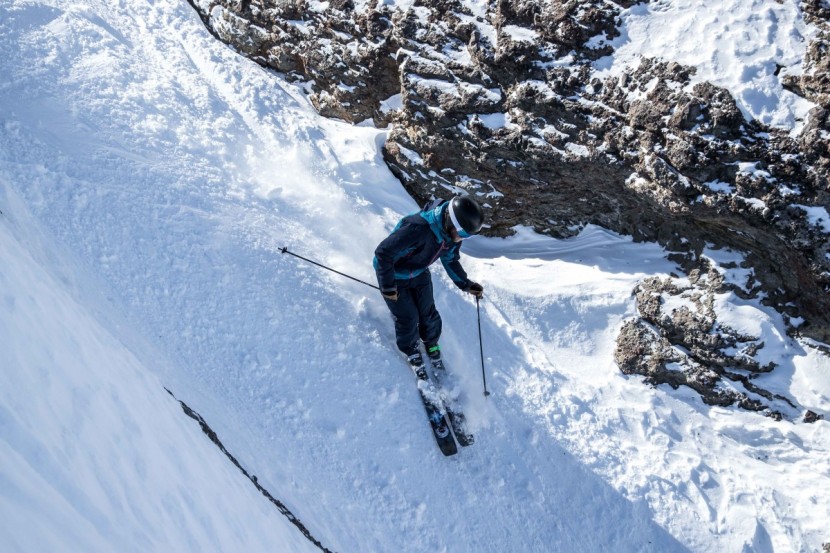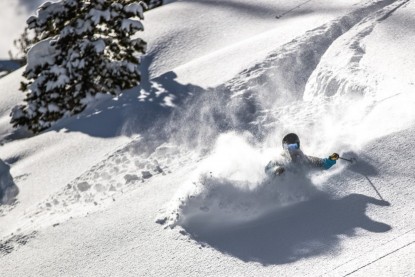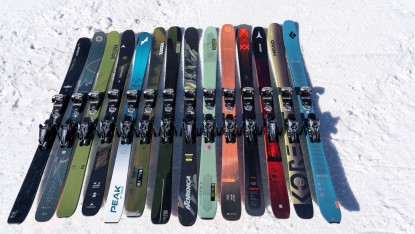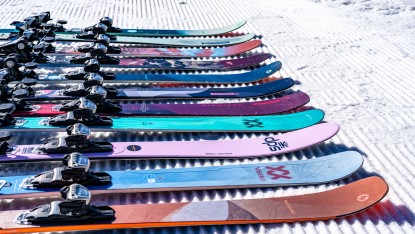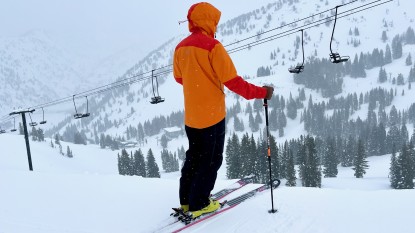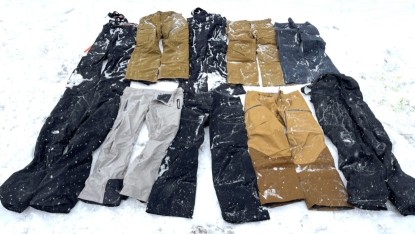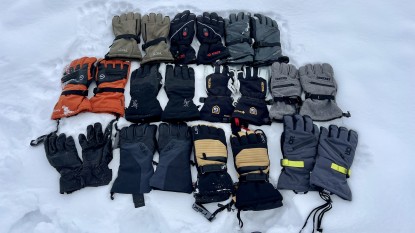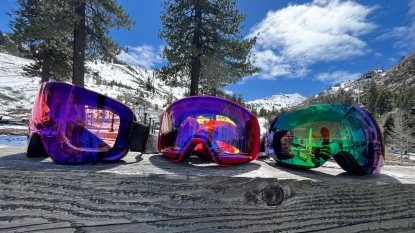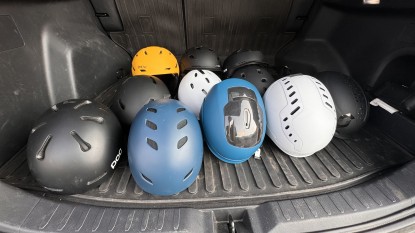Powder-specific skis have come a long way since the superfats of the '80's. Innovations in design and a rapidly-developing field of big-mountain athletes has driven creative ski construction in some wild directions—mostly for the better. But the current technology and diverse field of offerings in the pow-ski category has really elevated the performance of these notoriously-goofy fat boards. It's not uncommon for skiers to choose something that's 100+ underfoot as their daily driver nowadays.
Thankfully, many of the skis in this year's lineup don't sacrifice much when it comes to edge hold and on-piste stability. That being said, we selected a wide variety of shapes, materials, and designs to include in our hands-on review. Some of the challengers catered to a particular niche or skier type. Some of them were all-mountain mavericks. But they were all designed with a focus on floatation.
Most of these skis are dedicated lift-access powder tools. That is precisely how they were tested: continuous lapping through our favorite off-piste resort zones. Though some of them could be good crossover options if you're not a weight weenie, you'd be better served to check out the Backcountry Skis Review if you're looking for some fat planks that like to ski uphill too.
What Makes a Powder Ski?
To put it simply, powder specific skis are plumped-up, flexier iterations of all-mountain boards. They are designed with greater surface area and softer flex in mind to aid in deep floatation. Aside from overall girthier dimensions and more pronounced rocker patterns, there isn't much difference to be noticed in construction when you compare the two. Occasionally, you'll find an outlier that utilizes funky shapes or materials in an attempt to increase deep powder performance. Though, most of the skis in this roster followed in the footsteps of traditional alpine shapes.
There is no doubt that the skiing marketplace is heavily saturated with consumer options. An annual trip to SIA may very well overwhelm you rather than guide you to the perfect pair of sticks. Dedicated powder skis are a relatively new notion in the snowsports industry—but that hasn't stopped manufacturers from pumping out tons of divergent options for ski bums to dream about. With so many choices out there, finding the right powder ski can be daunting if you don't know what you're looking for. Check out our Powder Ski Review if you've already got something in mind. Otherwise, read on to learn what characteristics you might look for in a powder ski.
While this review focuses exclusively on powder skis, it's good to know the general design cues used in other categories as well. There are no hard-and-fast rules when it comes to drawing boundaries around a skis intended use. Manufacturers will generally tell you what they have designed a ski for, but very often, niche-specific models will have features that were inspired by other ski types. Here is a quick rundown of the different nuances in construction and performance.
All-Mountain
The “all-mountain” category, though exceedingly popular, is downright ambiguous. All-mountain is a blanket statement meant to denote that a ski is capable of tackling a wide variety of terrain and conditions without getting overly focused on a particular type of skiing. With loose categorical standards, all-mountain skis can be found in many forms; modified frontside carvers and slimmed-down, big-mountain guns would equally fit the bill. It all depends on skier preference.
In general, an all-mountain ski will have a moderate (80-100 mm) waist width and traditional camber profiles underfoot. It's also becoming commonplace for an all-mountain ski to include at least some form of early-rise or rocker profile to allow for easier tracking in variable snow. Usually, they will have a sidecut radius in the medium range or may even have multiple radii that allow the skier to execute a variety of turn shapes. To find an all-mountain quiver-killer capable of handling it all, check out our best men's skis review.
Big-Mountain/Freeride
Now that Freeride World Tour athletes are going bigger than ever before, the big-mountain freeride category has come into its own with the evolution of the sport. Expert skiers who prefer to ski in steep, unmanaged snowfields have been consistently pushing the boundaries of what's possible on skis—they need gear that can keep up. A true big-mountain ski will be stiff, wide, and long enough to handle high-speed runouts in sketchy conditions. Taking cues from powder boards and old-school race skis, they are designed to go big and hard and may be unforgiving to a skier that isn't up to the task.
Big-mountain skis tend to have fatter waist widths (100-125 mm) and longer turn radii (20+ m). Though usually directional, the industry trend is moving towards a freeride preference. Skis in this category are now being offered with near-twin construction and rockered tips and tails that allow skiers to get stunty while slashing huge lines. If you're a powerful, spine-slashing skier, then a burly big-mountain ski will help step-up your game.
Park/Pipe
These days, all the youths getting hyped on 'corked spins' and 'blunt grabs' are doing so on park skis. Previously known as 'twintips' park/pipe skis are the chosen tools of dedicated freestyle skiers. Simply speaking, park skis are just short, light, narrow skis with their tails turned up to accommodate switch landings more easily. They will often have more symmetrical construction and mounting points that evenly distribute the skiers weight and give a balanced feel while spinning, skiing backwards, or doing other steezy stuff.
Aside from a few designated differences, the relatively narrow dimensions and familiar sidecut of park skis make them very similar to some carving or all-mountain skis. Even though freestyle skiers of manufactured terrain have a very distinct style, their sticks are pretty standard fare. They usually come with a waist width of less than 90 mm and have a short to medium sidecut radius. Other than “twin” tails and sometimes edgy graphics, there isn't much to differentiate them from the pack.
Backcountry/Alpine Touring
Theoretically, you could slap AT bindings on any old ski and take them out in the backcountry. That doesn't mean you're going to have a good time. Backcountry skiing and alpine touring have recently experienced a surge in popularity, and ski manufacturers have responded by offering a plethora of options for the uphill skier. Now, the options amongst backcountry/alpine touring/ski-mountaineering skis are almost as diverse as the terrain they are used to access. They range from ultra-light, heavily-cambered skinny-skis that are primarily meant to go up, all the way to freeride-focused, rockered chargers that aren't unlike an inbounds powder ski.
In general, backcountry skis are intended to be lighter on the legs and will often include task-specific features like notched tips/tails for easier attachment of climbing skins. Depending on the type of terrain you're looking to tackle, their waist widths will vary from 70-90 mm for long tours and rapid ascents to 90-115 mm for low-angle powder laps. With low weight, we generally experience performance tradeoffs like increased chatter less damping ability. So if you're not stoked on skiing uphill, you'd be better off looking elsewhere.
Carving
Skiers who prefer to slay frontside corduroy with fanciful, high-speed arcs typically choose carving skis to help them accomplish their graceful turns. Modern carving skis are the offspring of a long lineage of slalom and GS racing skis. With considerable camber and stout sidewalls, they are engineered with a hardcore focus on edge hold, speed, and precision turning. Following in the footsteps of their racing brethren, carving skis are typically narrow-waisted, stiff, and have a pronounced sidecut.
You'd be hard-pressed to find a dedicated frontside carving ski with a waist fatter than 90 mm. With highly-specified designs, they are the best at what they're built to do: ripping high-speed turn shapes on hardpack. However, the same characteristics that enable them to shred like race boards limit their functionality when you venture off-piste. So, unless you plan to stay on groomed terrain until the cows come home, a carving ski is probably not the best option for you.
Powder
Perhaps the only ski category named after the type of snow it seeks out, powder skis are fabricated to manage deep days where floatation and maneuverability in blower is the preeminent focus. With that said, powder skis are now offered in a range of sizes, shapes, and performance characteristics. Whether they be stiff and long or soft and noodly, these fatboards are intended to get you through that storm cycle with a sh#t-eating grin on your face. Let's take a closer look at what constitutes the personality of a powder ski.
Now that we've run down the list of possible ski-types to choose from let's dive deeper into the specific traits you might look for in a powder ski. It is, after all, the reason you came here, right?
Length
Ski length is universally measured in centimeters. If you don't already know the ballpark range of ski lengths that you prefer, you will learn over time what sizes work best for your weight, height, ability, and style of skiing. As a rough guesstimation, you should choose a ski that stands somewhere between your chin and forehead when you rest the tails on the ground. It is commonly understood that larger, more aggressive skiers will be better suited with a longer setup. Longer skis take more power—or at the very least, more weight—to be turned effectively.
Most of the skis in this review fall in the 180-185 cm range, which is more-or-less considered to be the mid-range for ski length. Skis in this size will range will feel solid and stable to an intermediate skier, but may get rambunctious when steered by a larger skier. Additionally, lighter or more novice skiers would feel more comfortable taking a step down in length and finding something that is shorter than 180 cm. Thankfully, nearly all of the skis we reviewed offer smaller sizes than what we rode.
Stiffness
Ski manufacturers will hardly ever designate a skis stiffness with any kind of explicit measurement. This attribute is often defined by the user with a simple hand-flex test. For this reason, stiffness is inherently subjective and is based more off of 'feel' than anything else. A skis stiffness is a reflection of the core materials and construction methods—elements that don't present themselves without a bit of digging. Additional materials like fiberglass, titanium, and carbon will add to a ski's overall stiffness.
Stiffness is sometimes also related to a ski's damping ability. Stiff skis can charge through crud, chunder, and death cookies by 'dampening' the reactive forces before they reach your boot and cause you unwanted shin-bang. While this provides greater stability at speed, it can also translate to a less responsive drive if you don't have the necessary power and velocity to stimulate the ski. In general, soft skis prefer low-angle terrain with smooth surfaces while stiff skis are more lively on steep pitches at higher speeds.
Dimensions
Ski dimension, also known as width, is measured in millimeters. These measurements are commonly displayed as a set of three numbers: the widest part of the tip or shovel / the narrowest part underfoot / and the widest part of the tail. To illustrate, the dimensions of the Line Pescado are 158/125/147, from tip-to-tail.
When offhandedly speaking of dimensional widths, most skiers will refer to the “waist” width, or underfoot measurement. This is because the waist of a ski is the most active part of its construction. This is where you hold an edge and balance most of your weight. Waist width will determine how easily a ski will roll over on edge or float through deep snow. For the most part, a ski's waist width will determine what type of snow it is best suited for.
Powder skis are easily recognized by their chunky dimensions. Fat waists and broad shovels provide greater surface area to float with. Though, a plump ski takes more effort to put on edge if you're not in the soft, pillowy flake that they're intended for. If you want to balance your floatation abilities with reliable edge-to-edge quickness, you may want to pick a powder ski that is on the narrower end of the spectrum.
Sidecut & Turn Radius
Sidecut is used to describe the hourglass shape of a ski that results from the overall dimensional widths found from tip to tail. When looking down the length of a ski, sidecut is the perceptible curvature you see in the edge. This curvature allows the ski to make an arc when engaged in a turn. The size of the arc made by the ski is known as sidecut radius, or turning radius. Dramatic sidecuts make for short radius, snappy turns while moderate sidecuts provide a stable edge for high-speed, large radius turns.
If you're doing it right, a powder ski should spend more time surfing over soft snow than it does really laying an edge on firm surfaces. But nonetheless, sidecut will affect a ski's performance in powder. A smaller sidecut radius will allow skiers to pivot their skis more quickly in deep snow, providing greater maneuverability than a longer, more gradual sidecut. Unless you're an expert skier that likes to punch it down the fall-line, you'll probably feel more in control with a shorter sidecut radius.
Rocker/Camber Profile
Camber and rocker are quintessentially opposite ski characteristics. But it is becoming more and more common to see both utilized in ski construction; especially for all-mountain and powder models. When blended together, both camber and rocker bring something to the table. This combo yields a ski that has solid edge hold, underfoot stability, and an inclination to track over sluff, chowder, or any imaginable snow type. What's not to like about that?
Camber refers to the upward arcing shape of a ski when placed on the snow. An unweighted, fully-cambered ski will only make contact with snow at the tip and tail, leaving a high spot underfoot. Anything between these contact points is known as a skis 'effective edge'—the portion of the ski responsible for carved turns.
When you click into a cambered ski, your weight will flatten the edge which then acts like a type of suspension that gives you more grip and energy when engaged in a turn. Ubiquitous on dedicated alpine boards, cambered construction has been around for a while, but that doesn't mean it's outdated. You'll find camber on nearly every ski out ther for good reason.
Rocker is a newfangled wunderkind the ski-tech scene. It is perhaps most easily understood as a reversed camber, which is what some choose to call it. As a nod to waterski shapes and contours, a rockered ski aims to provide effortless float in frozen fluff. Today's top models have all kinds of proprietary rocker shapes and designs—though there seem to be some basic formulas for success.
Some models will have only rockered tips, or rockered tips and tails, also known as early-rise. This will let the ski break over deep snow while still providing stability and traditional camber underfoot. A blended rocker/camber profile will feel at home in a variety of conditions, but the addition of rocker brings the contact points closer to your boot and will shorten the effective edge. A fully-rockered ski will have only one contact point underfoot, with both tip and gradually rising away from the snow. This type of rocker has very little if any effective edge to speak of. These profiles are generally made for powder purists who don't spend time carving.
If you're planning to ski powder, you most certainly want at least some form of rocker on your sticks. Not a single ski in this review was devoid of rocker. Though, depending on where your preferences lie, certain profiles may tickle your fancy more than others. To boil it down: a powder ski with early rise or dual-rocker won't compromise as much on-piste stability. Whereas a fully-rockered ski will deliver epic floatation but may not perform as well on the hardpack.



